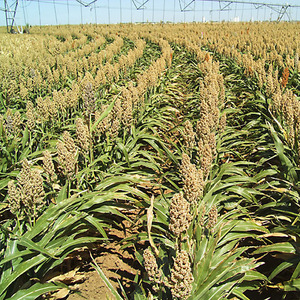USDA scientist helps Texas sorghum growers reduce water use

Susan O’Shaughnessy
July 31, 2015
BY USDA Agricultural Research Service
A USDA scientist is providing much needed guidance to sorghum farmers in the Texas High Plains who are trying to save water by using less-than-optimal amounts of it.
Farmers in the area are turning to sorghum because many of them suffered major losses raising corn during recent droughts and water shortages. Sorghum is more drought tolerant than corn, but growers need to know if they will get sufficient yields using less water. They also must decide whether to raise early-maturing sorghum varieties (which are planted later and are less vulnerable to drought) or late-maturing varieties (which produce higher yields if given enough water).
Advertisement
Susan O’Shaughnessy, an agricultural engineer with the USDA’s Agricultural Research Service in Bushland, Texas, evaluated yields and water-use efficiency of early- and late-maturing sorghum varieties produced under four levels of deficit irrigation. She and her colleagues planted late-maturing and early-maturing varieties at optimal times and harvested both types at about the same time in the fall. They grew the crops for three seasons, tracked weather data and rainfall levels, and measured evapotranspiration rates—an indicator of the plant’s overall water needs. Above-average rainfall occurred in 2009 and 2010, and much lower-than-average rainfall occurred in 2011.
They found that on average, over the three growing seasons, crop water-use efficiency (the water used by the crop in relation to the crop yield) was typically greatest at the 55-percent replenishment level, but even a 30-percent replenishment at least doubled the yields when compared with no irrigation. At 80-percent replenishment, the late-maturing variety consistently produced higher yields than the early-maturing one, but the early-maturing variety produced sufficient yields to make it a viable alternative. Growers also risk severe or total losses if they practice even moderate deficit irrigation during droughts. In fact, total crop failures are likely without at least some irrigation in drought years like 2011.
The results from this research should help farmers in regions with a growing season that has erratic rainfall, widely varying temperatures and extreme weather (hail, flooding and lightning).
Advertisement
Read more about this research in the July 2015 issue of AgResearch magazine. ARS is USDA’s principal intramural scientific research agency.
Related Stories
The USDA significantly increased its estimate for 2025-’26 soybean oil use in biofuel production in its latest World Agricultural Supply and Demand Estimates report, released July 11. The outlook for soybean production was revised down.
U.S. fuel ethanol capacity fell slightly in April, while biodiesel and renewable diesel capacity held steady, according to data released by the U.S. EIA on June 30. Feedstock consumption was down when compared to the previous month.
The U.S. EPA on July 8 hosted virtual public hearing to gather input on the agency’s recently released proposed rule to set 2026 and 2027 RFS RVOs. Members of the biofuel industry were among those to offer testimony during the event.
The USDA’s Risk Management Agency is implementing multiple changes to the Camelina pilot insurance program for the 2026 and succeeding crop years. The changes will expand coverage options and provide greater flexibility for producers.
The USDA’s National Agricultural Statistics Service on June 30 released its annual Acreage report, estimating that 83.4 million acres of soybeans have been planted in the U.S. this year, down 4% when compared to 2024.
Upcoming Events










